上海师范大学卜友红教授语音学笔试试卷
- 格式:doc
- 大小:109.50 KB
- 文档页数:6
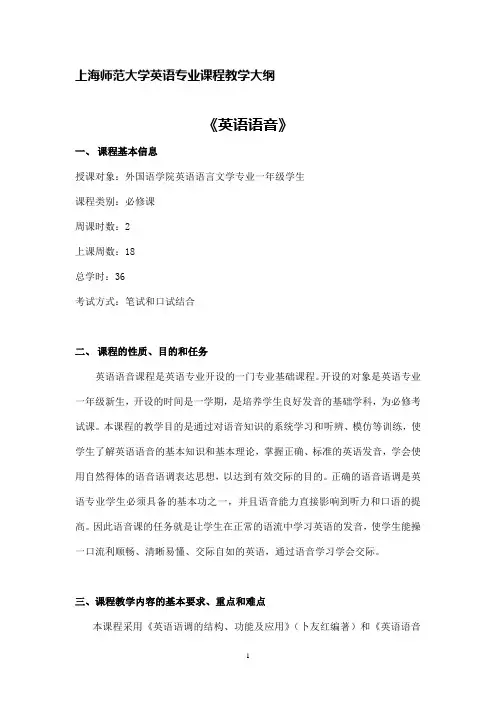
上海师范大学英语专业课程教学大纲《英语语音》一、课程基本信息授课对象:外国语学院英语语言文学专业一年级学生课程类别:必修课周课时数:2上课周数:18总学时:36考试方式:笔试和口试结合二、课程的性质、目的和任务英语语音课程是英语专业开设的一门专业基础课程。
开设的对象是英语专业一年级新生,开设的时间是一学期,是培养学生良好发音的基础学科,为必修考试课。
本课程的教学目的是通过对语音知识的系统学习和听辨、模仿等训练,使学生了解英语语音的基本知识和基本理论,掌握正确、标准的英语发音,学会使用自然得体的语音语调表达思想,以达到有效交际的目的。
正确的语音语调是英语专业学生必须具备的基本功之一,并且语音能力直接影响到听力和口语的提高。
因此语音课的任务就是让学生在正常的语流中学习英语的发音,使学生能操一口流利顺畅、清晰易懂、交际自如的英语,通过语音学习学会交际。
三、课程教学内容的基本要求、重点和难点本课程采用《英语语调的结构、功能及应用》(卜友红编著)和《英语语音教程》(王桂珍主编),教学内容基本按照课本编排的顺序实施。
内容主要包括:44个音素的发音,词重音,句重音,强读与弱读。
学生应掌握下列知识和技能:1.了解音素、音位变体、宽式标音和窄式标音、最小对立对、互补分布等基本概念;2.掌握英语44个音素的发音;3.了解英语的音节结构,掌握不同音素组合的发音;4.正确的把握词与词之间的过渡,使同一意群的词连贯、流畅地连接在一起;5.掌握每个多音节词的重音模式;熟悉并会使用单词的强读式与弱读式;6.正确地把握句子重音;掌握正确的话语节奏规律;7.正确得体地使用语调;最重要的是,通过使用正确的语音语调达到交际的目的。
8.本课程的重点和难点在于如何正确地把握重音、话语节奏规律及语调,也就是说,如何通过使用正确的语音语调达到交际的目的,形成自然流畅的语流,养成良好的口语习惯。
四、教学方式及学时分配语音课程是一门实践性比较强的课程,因此本课程采用的方法是进,讲授,举例,领读,课堂实践注重听说齐头并进。
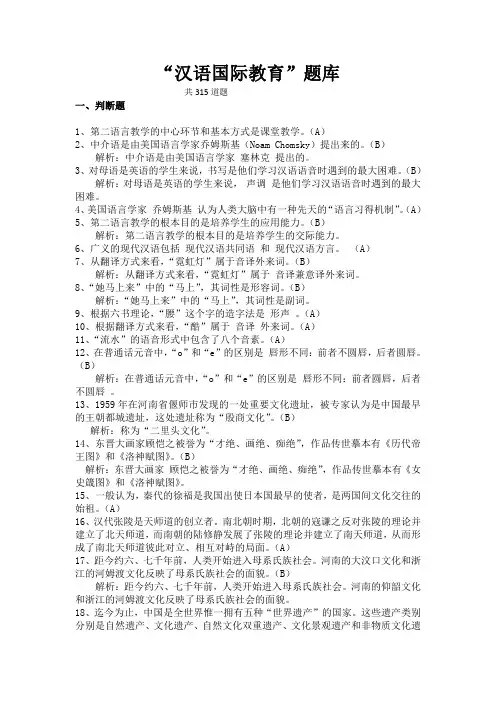
“汉语国际教育”题库共315道题一、判断题1、第二语言教学的中心环节和基本方式是课堂教学。
(A)2、中介语是由美国语言学家乔姆斯基(Noam Chomsky)提出来的。
(B)解析:中介语是由美国语言学家塞林克提出的。
3、对母语是英语的学生来说,书写是他们学习汉语语音时遇到的最大困难。
(B)解析:对母语是英语的学生来说,声调是他们学习汉语语音时遇到的最大困难。
4、美国语言学家乔姆斯基认为人类大脑中有一种先天的“语言习得机制”。
(A)5、第二语言教学的根本目的是培养学生的应用能力。
(B)解析:第二语言教学的根本目的是培养学生的交际能力。
6、广义的现代汉语包括现代汉语共同语和现代汉语方言。
(A)7、从翻译方式来看,“霓虹灯”属于音译外来词。
(B)解析:从翻译方式来看,“霓虹灯”属于音译兼意译外来词。
8、“她马上来”中的“马上”,其词性是形容词。
(B)解析:“她马上来”中的“马上”,其词性是副词。
9、根据六书理论,“腰”这个字的造字法是形声。
(A)10、根据翻译方式来看,“酷”属于音译外来词。
(A)11、“流水”的语音形式中包含了八个音素。
(A)12、在普通话元音中,“o”和“e”的区别是唇形不同:前者不圆唇,后者圆唇。
(B)解析:在普通话元音中,“o”和“e”的区别是唇形不同:前者圆唇,后者不圆唇。
13、1959年在河南省偃师市发现的一处重要文化遗址,被专家认为是中国最早的王朝都城遗址,这处遗址称为“殷商文化”。
(B)解析:称为“二里头文化”。
14、东晋大画家顾恺之被誉为“才绝、画绝、痴绝”,作品传世摹本有《历代帝王图》和《洛神赋图》。
(B)解析:东晋大画家顾恺之被誉为“才绝、画绝、痴绝”,作品传世摹本有《女史箴图》和《洛神赋图》。
15、一般认为,秦代的徐福是我国出使日本国最早的使者,是两国间文化交往的始祖。
(A)16、汉代张陵是天师道的创立者。
南北朝时期,北朝的寇谦之反对张陵的理论并建立了北天师道,而南朝的陆修静发展了张陵的理论并建立了南天师道,从而形成了南北天师道彼此对立、相互对峙的局面。
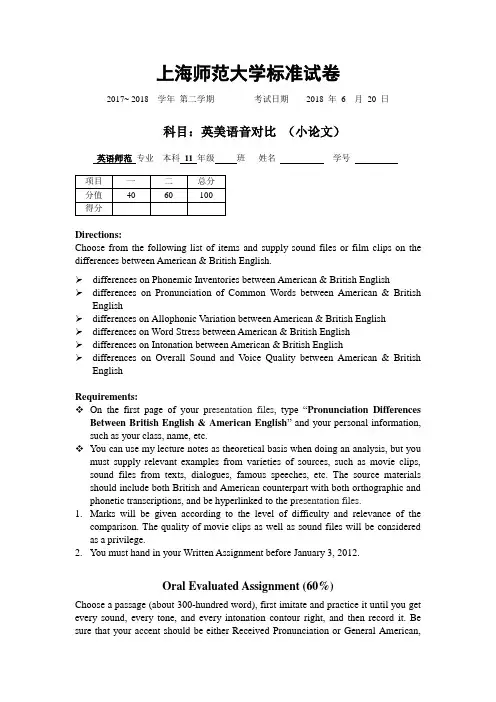
上海师范大学标准试卷2017~ 2018 学年第二学期考试日期2018 年6 月20 日科目:英美语音对比(小论文)英语师范专业本科11 年级班姓名学号Directions:Choose from the following list of items and supply sound files or film clips on the differences between American & British English.➢differences on Phonemic Inventories between American & British English➢differences on Pronunciation of Common Words between American & British English➢differences on Allophonic Variation between American & British English➢differences on Word Stress between American & British English➢differences on Intonation between American & British English➢differences on Overall Sound and V oice Quality between American & British EnglishRequirements:❖On the first page of your p resentation files, type “Pronunciation Differences Between British English & American English” and your personal information, such as your class, name, etc.❖You can use my lecture notes as theoretical basis when doing an analysis, but you must supply relevant examples from varieties of sources, such as movie clips, sound files from texts, dialogues, famous speeches, etc. The source materials should include both British and American counterpart with both orthographic and phonetic transcriptions, and be hyperlinked to the p resentation files.1.Marks will be given according to the level of difficulty and relevance of thecomparison. The quality of movie clips as well as sound files will be considered as a privilege.2.You must hand in your Written Assignment before January 3, 2012.Oral Evaluated Assignment (60%)Choose a passage (about 300-hundred word), first imitate and practice it until you get every sound, every tone, and every intonation contour right, and then record it. Be sure that your accent should be either Received Pronunciation or General American,but never mix the two accents into one.Hand in your recording, together with the word of the passage, including the source of and the original sound file of the passage.You will be graded on the accuracy of your pronunciation, the stress, the rise and fall of nuclear syllables, the rate of the speech tempo, the overall fluency of the speech and the sound quality of the recording.。
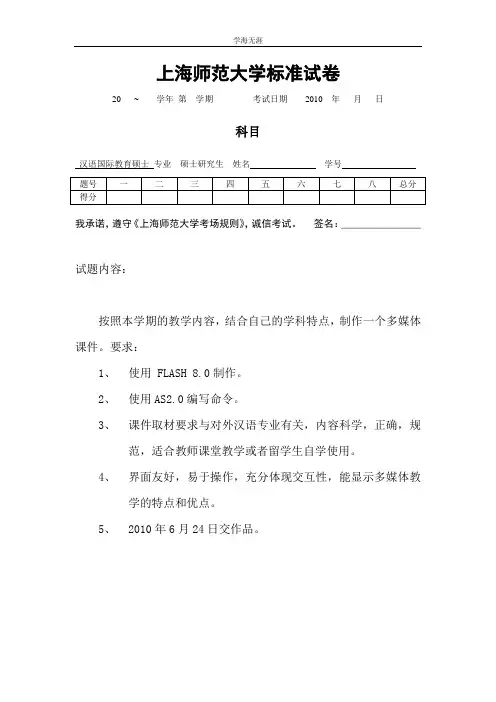
学海无涯
上海师范大学标准试卷
20 ~ 学年第学期考试日期2010 年月日
科目
汉语国际教育硕士专业硕士研究生姓名学号
我承诺,遵守《上海师范大学考场规则》,诚信考试。
签名:________________ 试题内容:
按照本学期的教学内容,结合自己的学科特点,制作一个多媒体课件。
要求:
1、使用 FLASH 8.0制作。
2、使用AS2.0编写命令。
3、课件取材要求与对外汉语专业有关,内容科学,正确,规
范,适合教师课堂教学或者留学生自学使用。
4、界面友好,易于操作,充分体现交互性,能显示多媒体教
学的特点和优点。
5、2010年6月24日交作品。
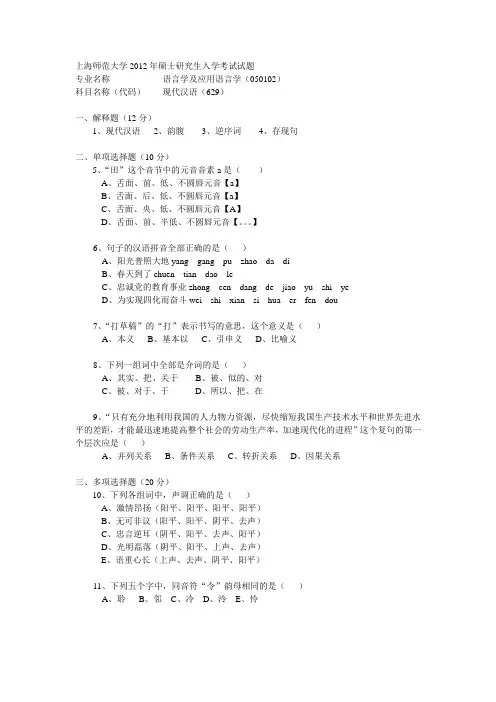
上海师范大学2012年硕士研究生入学考试试题专业名称语言学及应用语言学(050102)科目名称(代码)现代汉语(629)一、解释题(12分)1、现代汉语2、韵腹3、逆序词4、存现句二、单项选择题(10分)5、“田”这个音节中的元音音素a是()A、舌面、前、低、不圆唇元音【a】B、舌面、后、低、不圆唇元音【a】C、舌面、央、低、不圆唇元音【A】D、舌面、前、半低、不圆唇元音【。
】6、句子的汉语拼音全部正确的是()A、阳光普照大地yang gang pu zhao da diB、春天到了chuen tian dao leC、忠诚党的教育事业zhong cen dang de jiao yu shi yeD、为实现四化而奋斗wei shi xian si hua er fen dou7、“打草稿”的“打”表示书写的意思,这个意义是()A、本义B、基本以C、引申义D、比喻义8、下列一组词中全部是介词的是()A、其实、把、关于B、被、似的、对C、被、对于、于D、所以、把、在9、“只有充分地利用我国的人力物力资源,尽快缩短我国生产技术水平和世界先进水平的差距,才能最迅速地提高整个社会的劳动生产率,加速现代化的进程”这个复句的第一个层次应是()A、并列关系B、条件关系C、转折关系D、因果关系三、多项选择题(20分)10、下列各组词中,声调正确的是()A、激情昂扬(阳平、阳平、阳平、阳平)B、无可非议(阳平、阳平、阴平、去声)C、忠言逆耳(阴平、阳平、去声、阳平)D、光明磊落(阴平、阳平、上声、去声)E、语重心长(上声、去声、阴平、阳平)11、下列五个字中,同音符“令”韵母相同的是()A、聆B、邻C、冷D、泠E、怜12、下列五组词中,可以看作反义词的是()A、谦虚/骄傲B、太阳/月亮C、阴/阳D、红/绿E、黑/白13、下列成语中结构方式相同的是()A、高朋满座B、众叛亲离C、指鹿为马D、正本清源E、层出不穷14、下列各组加粗的词中不属于兼类词的是()A、方便了顾客;使顾客得到了方便B、了解是十分重要的;我太了解他了C、你怎么光说不做;这个人就喜欢光着膀子干活D、参加这次会议的有百把人吧;把被子弄脏的是谁E、你说的太对了;对他来说这问题太容易了四、操作题(18分)(一)按声母把下列各组字分成小组,指出每小组的声母,并说明各小组声母发音部位和发音方法的异同(每题4分,共8分,每题中发音部位和发音方法的分析各占2分)15、恰紧俏贤俊匠懈16、撇胚彬进聘盘畔(二)用框式图解法分析下列复杂短语,如果是多义的,请用不同的方法加以区别(17题、18题每题2分,19、20题每题3分,共10分)17、我有个弟弟没考上大学18、一种治疗气管炎的有效方法19、三个商店的营业员20、酒精和水里的杂质五、填表题(18分)22、列表分析下列各单位里包含几个语素,几个词,几个字,几个音节(共6分,每23、“爬得高”可以是结果补语可能式的肯定形式,也可以是情态补语的肯定形式,按照下列要求填表(6分,每空1分)六、问答题(第24题、27题每题13分,第25题、26题每题16分,第28题(或第29题)14分,共72分)24、说明“文言”与“白话”,“口语”与“书面语”之间的关系。
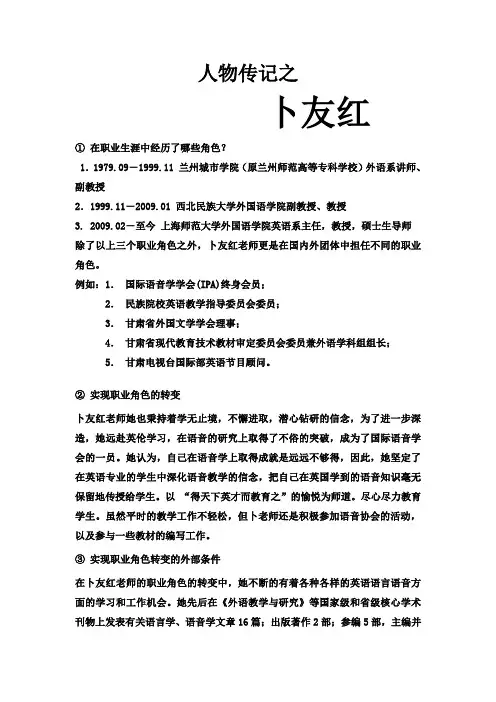
人物传记之卜友红①在职业生涯中经历了哪些角色?1.1979.09-1999.11 兰州城市学院(原兰州师范高等专科学校)外语系讲师、副教授2.1999.11-2009.01 西北民族大学外国语学院副教授、教授3. 2009.02-至今上海师范大学外国语学院英语系主任,教授,硕士生导师除了以上三个职业角色之外,卜友红老师更是在国内外团体中担任不同的职业角色。
例如:1.国际语音学学会(IPA)终身会员;2.民族院校英语教学指导委员会委员;3.甘肃省外国文学学会理事;4.甘肃省现代教育技术教材审定委员会委员兼外语学科组组长;5.甘肃电视台国际部英语节目顾问。
②实现职业角色的转变卜友红老师她也秉持着学无止境,不懈进取,潜心钻研的信念,为了进一步深造,她远赴英伦学习,在语音的研究上取得了不俗的突破,成为了国际语音学会的一员。
她认为,自己在语音学上取得成就是远远不够得,因此,她坚定了在英语专业的学生中深化语音教学的信念,把自己在英国学到的语音知识毫无保留地传授给学生。
以“得天下英才而教育之”的愉悦为师道。
尽心尽力教育学生。
虽然平时的教学工作不轻松,但卜老师还是积极参加语音协会的活动,以及参与一些教材的编写工作。
③实现职业角色转变的外部条件在卜友红老师的职业角色的转变中,她不断的有着各种各样的英语语言语音方面的学习和工作机会。
她先后在《外语教学与研究》等国家级和省级核心学术刊物上发表有关语言学、语音学文章16篇;出版著作2部;参编5部,主编并主讲中学英语教学录音磁带65盘,甘肃省教育厅曾两次发布文件,在全省范围内普及推广,另出版有关英语语音语调及听力录音带20余盘;为甘肃电视台国际部翻译、配音讲解电视剧40余部。
不是人人都有这样丰富的经历和机会的,而卜友红老师抓住了这些得来不易的社会机会,从一个讲师,到副教授,再到如今的教授兼硕士生导师。
因此,正是种种的良好的外部条件铸就了J. C. Wells 口中的中国“标准英语发音”(RP)的杰出代表人物——卜友红。
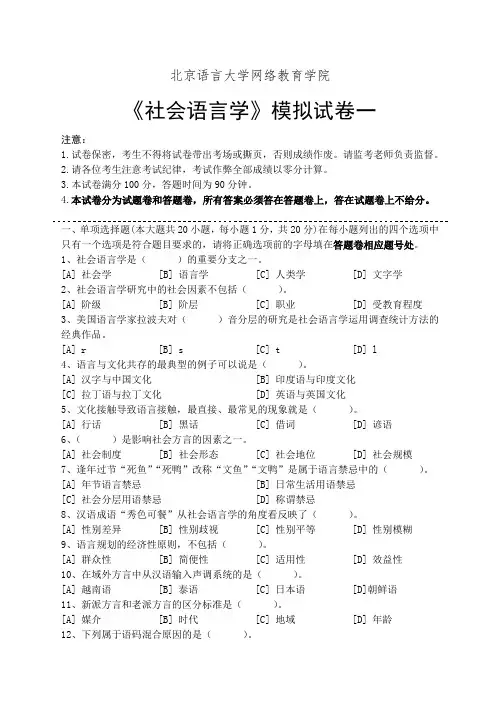
北京语言大学网络教育学院《社会语言学》模拟试卷一注意:1.试卷保密,考生不得将试卷带出考场或撕页,否则成绩作废。
请监考老师负责监督。
2.请各位考生注意考试纪律,考试作弊全部成绩以零分计算。
3.本试卷满分100分,答题时间为90分钟。
4.本试卷分为试题卷和答题卷,所有答案必须答在答题卷上,答在试题卷上不给分。
一、单项选择题(本大题共20小题,每小题1分,共20分)在每小题列出的四个选项中只有一个选项是符合题目要求的,请将正确选项前的字母填在答题卷相应题号处。
1、社会语言学是()的重要分支之一。
[A] 社会学[B] 语言学[C] 人类学[D] 文字学2、社会语言学研究中的社会因素不包括()。
[A] 阶级[B] 阶层[C] 职业[D] 受教育程度3、美国语言学家拉波夫对()音分层的研究是社会语言学运用调查统计方法的经典作品。
[A] r [B] s [C] t [D] l4、语言与文化共存的最典型的例子可以说是()。
[A] 汉字与中国文化[B] 印度语与印度文化[C] 拉丁语与拉丁文化[D] 英语与英国文化5、文化接触导致语言接触,最直接、最常见的现象就是()。
[A] 行话[B] 黑话[C] 借词[D] 谚语6、()是影响社会方言的因素之一。
[A] 社会制度[B] 社会形态[C] 社会地位[D] 社会规模7、逢年过节“死鱼”“死鸭”改称“文鱼”“文鸭”是属于语言禁忌中的()。
[A] 年节语言禁忌[B] 日常生活用语禁忌[C] 社会分层用语禁忌[D] 称谓禁忌8、汉语成语“秀色可餐”从社会语言学的角度看反映了()。
[A] 性别差异[B] 性别歧视[C] 性别平等[D] 性别模糊9、语言规划的经济性原则,不包括()。
[A] 群众性[B] 简便性[C] 适用性[D] 效益性10、在域外方言中从汉语输入声调系统的是()。
[A] 越南语[B] 泰语[C] 日本语[D]朝鲜语11、新派方言和老派方言的区分标准是()。
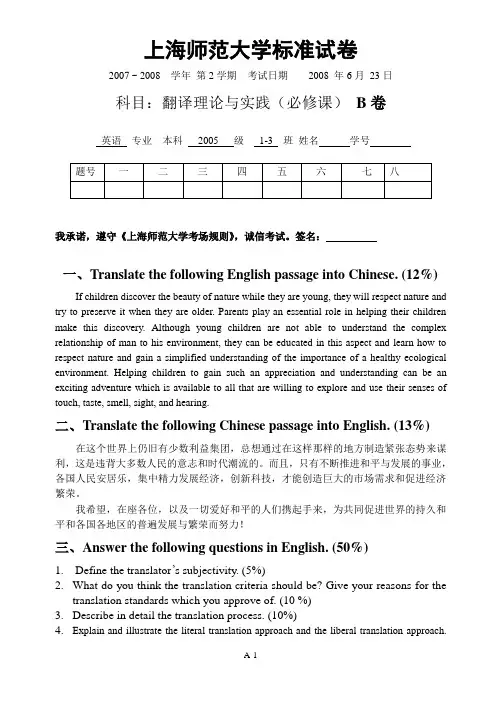
上海师范大学标准试卷2007 ~ 2008 学年第2学期考试日期2008 年6月23日科目:翻译理论与实践(必修课)B卷英语专业本科2005 级_1-3_ 班姓名学号我承诺,遵守《上海师范大学考场规则》,诚信考试。
签名:一、Translate the following English passage into Chinese. (12%)If children discover the beauty of nature while they are young, they will respect nature and try to preserve it when they are older. Parents play an essential role in helping their children make this discovery. Although young children are not able to understand the complex relationship of man to his environment, they can be educated in this aspect and learn how to respect nature and gain a simplified understanding of the importance of a healthy ecological environment. Helping children to gain such an appreciation and understanding can be an exciting adventure which is available to all that are willing to explore and use their senses of touch, taste, smell, sight, and hearing.二、Translate the following Chinese passage into English. (13%)在这个世界上仍旧有少数利益集团,总想通过在这样那样的地方制造紧张态势来谋利,这是违背大多数人民的意志和时代潮流的。
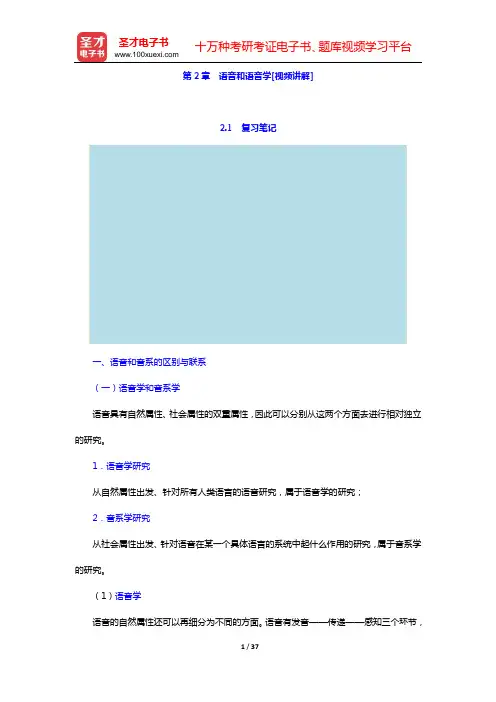
第2章语音和语音学[视频讲解]2.1 复习笔记一、语音和音系的区别与联系(一)语音学和音系学语音具有自然属性、社会属性的双重属性,因此可以分别从这两个方面去进行相对独立的研究。
1.语音学研究从自然属性出发、针对所有人类语言的语音研究,属于语音学的研究;2.音系学研究从社会属性出发、针对语音在某一个具体语言的系统中起什么作用的研究,属于音系学的研究。
(1)语音学语音的自然属性还可以再细分为不同的方面。
语音有发音——传递——感知三个环节,分别对应于生理一一物理——心理三个方面的属性,由语音学的三个分支发音语音学——声学语音学——听觉语音学分别加以研究。
语音学中最基本的是发音原理,这是学习和研究语言的人应该掌握的最重要的基础知识之一。
(2)音系学各种语言使用哪些材料,如何使用,这是音系学研究的内容。
学习音系学的知识,能使我们了解一个语言中哪些音是必须区别的,不同的音的出现条件是什么,它们的组合规律是什么,节律和语调又有哪些主要的特点,掌握语音在不同语言中的作用和组织方式。
3.语音学和音系学的关系音系学和语音学是有各自独立研究领域又彼此有交叉的两个学科。
(1)音系学与语音学相对独立①音系学的出发点在于语音在语言系统中的组织方式,属于语言学的核心部分;②语音学的出发点在于语音自身的自然属性或听觉反映,与语言学的核心部分是间接联系。
(2)音系学和语音学的研究彼此无法截然分开①音系学研究的就是有自然属性的语音在语言系统中的作用,这自然就需要先搞清楚语音的自然属性;②语音学研究的是语言中的声音和发出语言时的肌体动作,而不是自然界的声音或与语言无关的肢体动作,这就必然要在研究中关注语音自然属性在语言系统中的作用。
(二)语音和音系的最小线性单位——音素与音位1.语音单位与音系单位的比较(1)最小的语音单位和最小的音系单位都是从成串的话语中切分、归纳出来的。
(2)语音单位和音系单位有本质性的区别:①语音单位是针对所有人类语言来说的②音系单位是针对某一具体语言来说的。
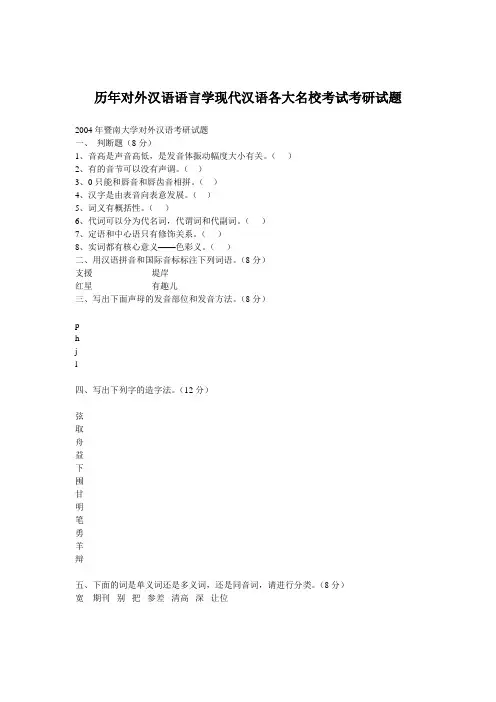
历年对外汉语语言学现代汉语各大名校考试考研试题2004年暨南大学对外汉语考研试题一、判断题(8分)1、音高是声音高低,是发音体振动幅度大小有关。
()2、有的音节可以没有声调。
()3、0只能和唇音和唇齿音相拼。
()4、汉字是由表音向表意发展。
()5、词义有概括性。
()6、代词可以分为代名词,代谓词和代副词。
()7、定语和中心语只有修饰关系。
()8、实词都有核心意义——色彩义。
()二、用汉语拼音和国际音标标注下列词语。
(8分)支援堤岸红星有趣儿三、写出下面声母的发音部位和发音方法。
(8分)phjl四、写出下列字的造字法。
(12分)弦取舟益下囤甘明笔勇羊辩五、下面的词是单义词还是多义词,还是同音词,请进行分类。
(8分)宽期刊别把参差清高深让位六、写出下列词的词性(15分)同等非法一致一概类似以外套怎么让的七、写出下列短语的结构类型和功能类型(15分)天亮以前准备做饭做饭做菜亲自体验去北戴河疗养气得头疼劝老王去你们几位触电一样春天的到来八,分析下面句子,是单句的分析成分,是复句分析层次(20分)(没抄全,有例句可以参考)1、虽然我们但是2、的保存是我们(现代汉语书上有这个句子)3、只要而且九指出下列一段话在语音上的修辞特色。
(6分)(一段写景的句子,用了很多个叠词和几个成语,象声词)九,简答题(20分)1、为什么揉面能够成立,揉水、揉石头不能成立,请用义素分析法分析。
2、家:成家画家作家安家老人家音乐家持家姑娘家孩子家科学家老家美食家请将这些词语归类,说出理由。
十、问答题(30分)1、音位和音素有何区别和联系,请举例论述。
2、汉语的连词与复句的关系是怎样的,请举例论述。
2005年暨南大学硕士研究生入学试题(华文学院)科目:语言学及应用语言学方向:语言学概论及古代汉语(略)和写作一名词解释(18分)音素音位音节义素义项语素二简答题(32分)⒈为什么说”说话只能在有限和无限,自由和不自由的矛盾中运行?”(5分)⒉划分和归纳音位的主要依据(原则)有哪些?(6分)⒊外语学习中的句型”替换”联系是按语言学什么原理设计的?(6分)⒋基本语法结构有哪五种?各自概括的语法意义是什么?提供语法形式的手段主要有哪几种?(9分)⒌用变换分析法说明以下句子在句法意义上的差异?(6分)①台上做着主席台②台上唱着戏③台上摆着酒席三论述(10分)从汉字长期停留于意音文字阶段看文字体系变革的条件?八写作(30分)以<<标语与社会>>为题写一篇小论文.2005年暨南大学硕士研究生入学试题(华文学院)科目:语言学及应用语言学方向: 现代汉语(中间题目太琐碎,就没有一一记下,主要是没有时间,题目都很基础,把书看仔细了就可以了,强烈建议在看完书后,找些相关的练习来做做,祝你成功!)一名词解释(10)1《汉语拼音方案》2汉字的内定3根词4词的兼类5拈连二填空(10)三单选(10)四多选(5)五判断(10)六填表(10)①音节结构(5)(注:给你一个字,让你指出声母,韵头,韵腹,韵尾之类,当然还有调职调类好像还有该字是几画)②语素词字音节(5)(注:给你若干汉字,比如“巧克力”之类的让你判断七分析(35)1 加音标2 简化方法3 词的构造4 构词方式5 分析句子他被同学送回家把病治好了6 分析复句7修辞格(注:就一个长句,判断包括哪些修辞手法)八改错(句子)(10)(也就是修改病句)九简答题(50)1 什么是现代汉语规范化?如何看待新出现的语言现象?2 下列汉字哪些是形声字?说明形声字出现的意义?雨切刃抢卡竿木(本)从3 以“现在”“正在”为例,说明时间名词和时间副词在语法功能上的异同?4 汉语的词类和句子成分之间有怎样的对应关系?谈谈你的看法。
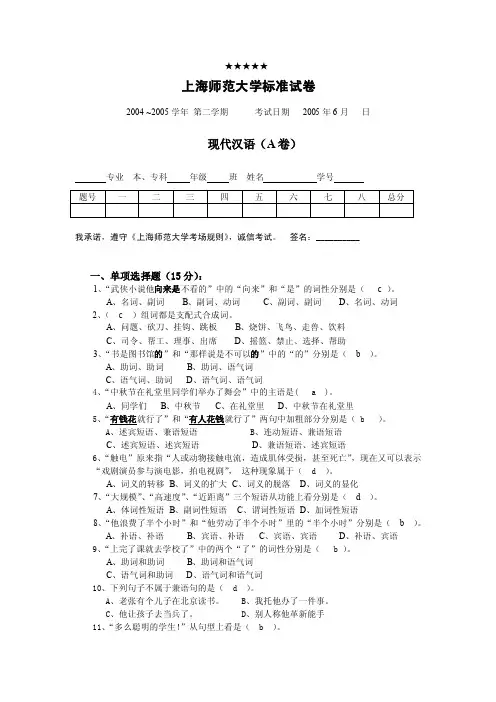
★★★★★上海师范大学标准试卷2004 ~2005学年第二学期考试日期2005年6月日现代汉语(A卷)专业本、专科年级班姓名学号我承诺,遵守《上海师范大学考场规则》,诚信考试。
签名:__________一、单项选择题(15分):1、“武侠小说他向来是不看的”中的“向来”和“是”的词性分别是( c )。
A、名词、副词B、副词、动词C、副词、副词D、名词、动词2、( c )组词都是支配式合成词。
A、问题、砍刀、挂钩、跳板B、烧饼、飞鸟、走兽、饮料C、司令、帮工、理事、出席D、摇篮、禁止、选择、帮助3、“书是图书馆的”和“那样说是不可以的”中的“的”分别是( b )。
A、助词、助词B、助词、语气词C、语气词、助词D、语气词、语气词4、“中秋节在礼堂里同学们举办了舞会”中的主语是( a )。
A、同学们B、中秋节C、在礼堂里D、中秋节在礼堂里5、“有钱花就行了”和“有人花钱就行了”两句中加粗部分分别是( b )。
A、述宾短语、兼语短语B、连动短语、兼语短语C、述宾短语、述宾短语D、兼语短语、述宾短语6、“触电”原来指“人或动物接触电流,造成肌体受损,甚至死亡”,现在又可以表示“戏剧演员参与演电影,拍电视剧”,这种现象属于( d )。
A、词义的转移B、词义的扩大C、词义的脱落D、词义的显化7、“大规模”、“高速度”、“近距离”三个短语从功能上看分别是( d )。
A、体词性短语B、副词性短语C、谓词性短语D、加词性短语8、“他浪费了半个小时”和“他劳动了半个小时”里的“半个小时”分别是( b )。
A、补语、补语B、宾语、补语C、宾语、宾语D、补语、宾语9、“上完了课就去学校了”中的两个“了”的词性分别是( b )。
A、助词和助词B、助词和语气词C、语气词和助词D、语气词和语气词10、下列句子不属于兼语句的是( d )。
A、老张有个儿子在北京读书。
B、我托他办了一件事。
C、他让孩子去当兵了。
D、别人称他革新能手11、“多么聪明的学生!”从句型上看是( b )。
练习1 1. There is no logical connection between meaning and sounds. A dog might be a pig if only the first person or group of persons had used it for a pig. This is one of the design features of language.A. duality B. arbitrariness C. productivity D. displacement2. Language is a system of two sets of structures, one of sounds and the other of meaning. This is . It makes people possible to talk everything within his knowledge.A. dualityB. arbitrarinessC. productivityD. displacement3. ___ refers to the ability to construct and understand an indefinitely large number of sentences in one‘s native language, including those that he has never heard before, but that are appropriate to the speaking situation .A. duality B. arbitrariness C. productivity D. displacement4. __ __ refers to the fact that one can talk about things that are not present, as easily as he does things present. The dog couldn‘t be bow-wowing sorrowfully for some lost love or a bone to be lost. A. duality B. arbitrariness C. productivity D. displacement5. ______ means language is not biologically transmitted from generation to generation, but the linguistic system must be learnt anew by each speaker.A. dualityB. ArbitrarinessC. interchangeabilityD. cultural transmission6. ______ means that any human being can be both a producer and a receiver of messages.A. dualityB. ArbitrarinessC. interchangeabilityD. cultural transmission7. To say ―How are you.‖ ―Hi‖ to your friends is the ____ __of language.A. directive functionB. informative functionC. phatic functionD. interrogative function8. ―Tell me the result when you finish.‖ If you want to get your hearer to do something, y ou should use the _____ of language.A. directive functionB. informative functionC. phatic functionD. interrogative function9. A linguist regards the changes in language and language use as __ ___.A. unnaturalB. something to be fearedC. naturalD. abnormal10. A linguist is interested in ___A. speech sounds only B. all sounds C. vowels only11. Which of the following sounds is a voiceless bilabial stop? A. [t] B. [m] C. [b] D. [p12. Which of the following sounds is a voiced affricate? A. [y] B. [t∫] C. [z] D. [dЗ]13. Which of the following sounds is a central vowel? A. [ ə ] B. [ i ] C. [ou] D. [a: ]14. In the following sounds , ______ is a palatal fricative ? A. [ s ] B. [∫] C. [ l ] D. [θ]15. In the following sounds, _____ is a voiceless affricative? A. [dЗ] B. [v] C. [t∫] D. [θ]16. In English if a word begins with a [ l ] or [ r ],then the next sound must be a __ __.A. fricativeB. nasal soundC. semi-vowelD. vowel17. Of the ―words‖ listed below___ is not an English wordA. [r∧b ]B. [ læ b ]C. [məsta:∫]D. [lmæp]18. ___ are produced when the obstruction created by the speech organs is total and audibly released. A. Back vowels B. Stops C. Fricatives D. Glides19. The International Phonetic Association devised the INTERNATIONAL PHONETIC ALPHABET in _____. A. 1965 B. 1957 C. 1888 D. 178820. ___ is a phonological unit , and it is a unit that is of distinctive value.A. PhoneB. PhonemeC. AllophoneD. Sound1. [ f ] is a dental consonant. F2. Phonology studies the characteristics of speech sounds and provides methods for their description, classification and transcription. F 7. The three / p / are allophones. T3. Phoneme is a phonological unit. T4. Phone is a phonetic unit. T5. When we study the different [ p ]‘s in ―[ pit ], [tip ], [spit ]‖ , they are similar phones which belong to phonetics. T6. But the three [ p ] belong to the different phoneme / p /. F8. ‗peak‘is aspirated , phonetically transcribed as [ph]; ‗speak‘ is unaspirated phonetically[ p=]. T9. [ph ], [p=] do not belong to the same phoneme / p /. F10. [p h] and [ p=] are two different phones, and are variants of the phoneme / p /, which is called ALLOPHONES of the same phoneme. T.语义学练习1._______ is not included in Leech‘s associative meaning.A. Connotative meaningB. Social meaningC. Collocative meaningD. Thematic meaning2. Among Leech‘s seven typ es of meaning is concerned with the relationship between a word and the thing it refers to _____. A. conceptual B. affective C. reflected D. thematic3. According to the referential theory, a word is not directly related to the thing it refers to. They are connected by ____. A. meaning B. reference C. concept D. sense4.‖Big‖ and ―Small‖ are a pair of __ opposites.A. complementaryB. gradableC. completeD. Converse5. The pair of words ―same‖ and ―different‖ are _____.A. gradable oppositesB.converse oppositesC. hyponymsD.contradictory6. A word with several meaning is called ______ word.A. a polysemousB. a synonymousC. an abnormalD. a multiple7. The semantic components of the word ―gentleman‖ can be expressed as __.A. +animate, +male, +human, -adultB. +animate, +male, +human, +adultC. +animate, - male, +human, - adultD. +animate, - male, +human, +adult8. ______is the implied meaning, similar to ―implication‖ and ―implicature‖. E.g. When we mention about ―women‖, we‘ll think of her soft warm manner.A. DenotationB. Affective meaningC. Reflected meaningD. Connotation9. In the triangle advanced by Ogden and Richards, ―thought or reference‖ is_ __A. word, sentenceB. the objectC. conceptD. symbol10. A linguistic is interested in ___A. What is said.B. What is right both in syntax and in semantics.C. What is grammaticalD. What ought to be said.11. The pair of words ―lend‖and ―borrow‖ are ___A. gradable oppositesB. relational oppositesC. synonymsD. co-hyponyms12. Nouns, verbs, and adjectives can be classified as _____.A. Lexical wordsB. grammatical wordsC. function wordsD. form words13. What is the meaning relationship between the two words ―flower/tulip‖ ?A. PolysemyB. HomonymyC. HyponymyD. Antonymy14. The words ―railway‖ and ―railroad‖ are ___A. synonyms differing in emotive meaningB. dialectal synonymsC. collocationally-restricted synonymsD. synomyms differing in styles15. The pair of words ―wide/narrow‖ are called__A. gradable oppositesB. complementary antonymsC. co-hyponymsD. relational opposites16. Which of the following two-term sets shows the feature of complementaries?A. single/marriesB. lend/borrowC. hot/coldD. old/young17. The name of ―Morning Star‖, ―Evening Star‖ and ―Venus‖ is one of the example that different words or name may refer to the same ____A. denotation B. connotation C. reference D. sense18. When we analyze the words ―thrifty, economical, stingy‖they are synonyms but they have different______A. stylistic meaningB. denotative meaningC. affective meaningD. collocational meaning20. ―Seeing those pictures reminds him of his childhood.‖ The und erlined part in the sentence is_A. agent caseB. object caseC. instrument caseD. benefactive case1. Is reference tied to a particular time and place? T2. Every word in a language can find at least one referent in the objective world. ? F3. Can different expressions have the same referent? T4. Can reference be applied to words such as ―and‖ ,‖very‖ in English? F1. Sense is regarded as a kind of intra-linguistic relationship. T2. In most cases, ―sense‖ and ―meaning‖ are different terms for the same thing. T3. Every word has its own sense. F4. A word may have several different senses and several words may have the same sense. T5. Extension, like denotation, is a kind of relation between elements and the objective world. T6. A: He married a blonde heiress. B: He married a blondeThe relation between these two sentences is entailment. F?7. The relation between extension and intension is the same as that between connotation and denotation. T8. People of different cultures may choose different prototype for the same predicate, e.g. ‗bus‘. T9. All the words in a language can be used to refer , but only some have sense. F10. Two synonymous words must be identical in sense in every dimension. F11. There are very few perfect synonyms in a language. T12. Entailment is more inclusive than paraphrase. T13. Almost every word in a dictionary is polysemic. T14. Dry and wet are a pair of gradable antonyms. T15. Innocent and guilt are a pair of relative antonyms. F16. The relationship between the Argument and Predicate is Subject to predicate. FVI. Fill in the blanks in the following passage by choosing the appropriate word.Semantics is the study of ______(1) of language. It is one of the three components of _______(2) . According to Chomsky‘s theory , it is at the _______(3) level of language. Semantics concentrates on the _______(4) between languages, rather than on the _______(5).1. A. grammar B. structure C. phonetics D. meaning2. A. linguistics B. grammar C. morphology D. syntax3. A. surface structure B. deep structure C. linguistic D. philosophical4. A. form B. similarity C. differences D. meaning5. A. substance B. difference C. similarities D. grammarMost language utterances(话语)depend for their interpretation upon the ________(6) in which they are used, and the vast majority of them have a ________(7) range of meanings than first come to mind. It may seem to you that meaning is so vague, insubstantial, and elusive that it is impossible to come to any clear, concrete, or tangible conclusions about it. Although many kinds of behavior can be described as _______(8), the range, diversity and complexity of meaning expressed in language is unmatched in any other human or non-human communicative behavior. And linguistic________(9)6. A. words B. sentences C. structure D. context7. A. wider B. narrower C. more accurate D. clearer8. A. productive B. effective C. informative D. communicative9. A. stylistics B. philosophy C. semantics D. grammar--the study of meaning in language was neglected very largely in the past because meaning was felt to be inherently ______(10) and at least temporarily beyond the scope of ______(11) investigation. Largely as a result of Chomsky‘s theory of ______ (12) grammar, and the technical advances made in linguistics, in logic and philosophy of _______(13) , linguistic semantics is currently enjoying a very considerable revival of interest.10. A. stable B. unstable C. social D. arbitrary11. A. independent B. philosophical C. linguistic D. human12. A. traditional B. transformational C. structural D. systemic13. A. language B. semantics C. the world D. human mind.词汇练习1. The pair of words ―lend‖ and ―borrow‖ are ______.A. gradable oppositesB. relational oppositesC. SynonymsD. co-hyponyms2. The semantic components of the word ―woman‖ can be expressed as ______.A. +animate, +human, +male, -adultB. +animate, +human, -male, -adultC. +animate, +human, +male, +adultD. +animate, +human, -male, +adult3. What is the meaning relationship between the two words ―desk and furniture‖?A. PolysemyB. HomonymyC. HyponymyD. Antonymy4. The words ―dog‖ and ―read‖ are called ______because they can occur unattached.A. derivational morphemesB. bound morphemesC. inflectional morphemesD. free morphemes?9. Some morphemes have more than one invariable form , such as “dog→dogs”, “cat→cats”“mouse→mice”,which are called_____.A. bound morphemeB. allomorphC. free morphemeD. minimal morpheme10. In English n. v. a. and adv. make up the largest part of the vocabulary. They are also called _____.A. closed class words B. conventional words C. open class words D. compounds11. ______ can be used independently without being combined with other morphemes.A. Free morphemesB. Bound morphemesC. AffixesD. Roots12. The word ―bookish‖ contains two _____.A. phonemesB. morphsC. morphemesD. allomorphs13. ____ morpheme are those that cannot be used independently but have tobe combined with other morphemes, either free or bound, to form a word.A. FreeB. BoundC. RootD. Affix14. ______ modifies the meaning of the stem, but usually do not change the partof speech of the original word.A. PrefixesB. SufficesC. RootsD. Affixes15. The words ―make, bus‖ are called ______.A. derived morphemesB. inflected morph.C. bound morphD. free morpheme16. Which is variable word?A. fromB. untilC. workD. and17. Which processes of lexical change does the Chinese word “国务院”experienced?A. BlendingB. AbbreviationC. BorrowingD. Back-formation18. Which word is created through the process of acronym?A. adB. editC. AIDSD. Bobo19. The word ―math‖ is formed through ___.A. back formationB. clippingC. BlendingD. derivation20. ______ is the branch of grammar that studies the internal structure of words, and the rules by which words are formed. A. Affix B. Inflection C. Allomorph D. Morphologysyntax练习1. When we say that we can change the second word in the sentence ―He is waiting outside‖ with ―was‖. We are taking about ____inside the sentence.A. Syntactic relationsB. paradigmatic relationsC. Linear relationsD. Government2. The part of the grammar that represents a speaker‘s knowledge of the structure of phrases and sentences is called______ .A. Lexicon B. morphology C. Syntax D. semantics3. What does ‗IC‘ stands for as a syntactic notion and analytical technique ?A. Inferential ConnectiveB. Inflectional ComponentC. Immediate ConstituentD. Implicative Communication4. If we are to use the technique of IC analysis to analyze the sentence ―She broke the window with a stone yesterday‖, where is the first cut?Draw a tree diagram of this sentence.A. between stone and yesterdayB. between she and brokeC. between broke and the windowD. between window and with5. ____ is the defining properties of units like noun (number, gender, case) and verb (tense, aspect, etc.).A. Phonology B. Word classes C. Grammatical categories D. Functions of words6. Which of the following items is not one of the grammatical categories of English ?A. genderB. numberC. caseD. voice7. ____ is a relationship in which a word of a certain class determines the form of others in terms of certain categories.A. ConcordB. Immediate constituentC. Syntagmatic relationsD. Government8. ____ proposed to define sentence as the maximum free form.A. BloomfieldB. ChomskyC. HallidayD. Sussure9. The phrase ―boys and girls ‖ is a(n) _____.A. subordinate endocentric constructionB. coordinate endocentric constructionC. subordinate exocentric constructionD. coordinate exocentric construction10. Chomsky holds that the major task of linguistics is to _____.A. study real ‗facts‘ in daily settingsB. tells people how to speak appropriatelyC. tell people what is right in language useD. Look for ‗the universal grammar‘11. What is the full form of LAD? B. Language acquisition device12. A speaker‘s actual utterance in Chomsky‘s terminology is called _____.A. deep structureB. linguistic universalsC. universal grammarD. surface structure13. Chomsky studies language from a psychological point of view, holding that language is a form of ____; while Halliday focuses on the social aspect of language, regarding language as a form of ____. A. knowing, doing B. knowing, thinking C. thinking, doing D. doing, knowing 14.F. de Saussure is a(n) _____ linguist .C. Swiss15. What is the construction of the sentence ―The boy smiled‖?A. ExocentricB. EndocentricC. CoordinateD. Subordinate16. ―You sit down‖ is transformed into ―Sit down‖. Which transformational rule is used according to TG Grammar ? A. Copying B. Addition C. Reordering D. Deletion17. L. Bloomfield is a famous _____ structural linguist.C. American18. In ______ , Noam Chomsky published his famous book ―Syntactic Structure‖.B.195719. ―A fish is swimming in the pond‖ is transformed into ―There is a fish swimming in the pond‖. Which transformational rule is used. A. Copying B. Reordering C. Addition D. Deletion20.The phrase ―the man about whom I‘ve been talking.‖ belong to the ______Construction.A. predicateB. endocentricC. subordinateD. exocentric1.Traditional grammar involves a great deal of gender, number and case. T2. ―I‘m a teacher.‖ ―He studies English.‖ describe the form of gov ernment.3. ―Langue‖ is much more stable than ―parole‖. T4. When we mentioned about the usage of a ―树”,it is signified; and the sound /shu:/ is signifier, the relationship among them is arbitrary. T5. The sentence ― If the weather is nice, we‘ll go out.‖ is settled at the base paradigmatic relation.F6. Sassure proposed the linguistic study considered in itself. T7. Rheme contributes much more great than theme. F8. IC analysis is used to analyze the semantic feature of the sentence. F12. ―He came back very late last night.‖ The underlying structure is endocentric one. T13. Wh en we mention about ―phonetic‖and ―lexicon components‖, they belong to deep structure category. F14. The abstract meaning and ambiguity of the sentence can be analyzed by deep structure. T15. Systemic – functional grammar wanted to link the function with structure of the language.16.By synchrony we mean to study language change and development. F17. The open-class words include prepositions. F18. ―The boy smiled‖ has an exocen tric structure. T19. The IC Analysis is not able to analyze split verbs like ―do sb. in‖. T20. Langue is relatively stable and systematic while parole is subject to personal and situational constraints.21. Phonology is a branch of linguistics which studies the sentence patterns of a language. F6语用练习1. According to C.Morris and R. Carnap, _____ studies the relationship between symbols and their interpreters of a listener.A. SyntaxB. SemanticsC. PragmaticsD. Sociolinguistics2. There are ______deixis in the sentence ― she has sold it here yesterday. ‖.A. 3B. 4C. 5D. 63. We can do things with words ---- this is the main idea of ______.A. the Speech Act TheoryB. the Co-operative principlesC. the Polite principlesD. pragmatics4. _____refers to the utterance of a sentence with determinate sense and reference.A. Locutionary actB. Illocutionary actC. Perlocutionary actD. Speech act5. _____ may be used as an example of indirect speech act.A. ―I‘ll declare Mr. Williams election tomorrow.‖B. ―Good morning!‖C. ―could you open the window?‖D. ―I command you to report at 6 in the morning tomorrow. ‖6. A: Let‘s get something to kids. B: Okey , but not I-C-E C-R-E-A-M-S.In the conversation B violets the _____.A: Quantity Maxim B. Quality Maxim C. Relevance Maxim D. Clarity Maxim 7. A: I really like the dinner. B: I‘m vegetarian. There is a _____ violation in the conversation.A. QuantityB. QualityC. RelevanceD. Clarity8. A: How are you? B: I‘m dead. There is a _____ violation in the conversation.A. QuantityB. QualityC. RelevanceD. Clarity9. A: Would you like a cocktail? It‘s my own invention.B: Well, m mm uh it‘s not that we don‘t drink. There is a _____ violation in the conversation.A. QuantityB. QualityC. RelevanceD. Clarity10. A: Are you going to Steve‘s barbecue?B: A barbecue is an outdoor party.There is a _____ violation in the conversation.A. QuantityB. QualityC. RelevanceD. Clarity11. Pragmatics differs from traditional semantics in that it studies meaningnot in isolation, but in _____.A. relationshipB. dependenceC. sentenceD. context12. To analyze the following sentences ______ is Performative.A. You congratulate me.B. I envy you.C. I command you to put out that cigarette.D. I warned you not to go.13. _____ act expresses the intention of the speaker.A. LocutionaryB. IllocutionaryC. PerlocutionaryD. Speech act14. A: Do you know where Mr. Brown is? B: Somewhere in the suburbs of the city.Speaker B violates the maxim of _______.A. quantityB. qualityC. RelevanceD. Clarity15. A: The hostess is an awful bore. Do you think?B: The roses in the garden are beautiful, aren‘t they? Speaker B violates the maxim of _____.A. qualityB. quantityC. RelevanceD. Clarity16. A: This bag is a little bit heavy. B: Let me help you. What is the illocutionary act of speaker A?A. This bag is heavy.B. I don‘t want to carry it away.C. Could you help me with this bag?D. I‘m very happy about it.17. A: The dress she is wearing is beautiful, isn‘t it? B: The pattern is nice.What cooperative maxim does speaker B observe?A. QualityB. QuantityC. RelevanceD. Clarity18. Speech Act Theory was proposed by _____ in the late 50‘s of the 20th century. A. John Austin19. One of the contributions ____ has made is his classification of illocutionary acts. John Austin20. Cooperative principle was found by _____. A. Paul Grice21. According to Austin‘s Speech Act theory, the actual uttering of a sentence with a particular meaning is called ___ A. Perlocutionary B. locutionary C. illocutionary D. indirect speech. 22. A(n )‖_____‖ means that some sentences, in the utterance and the seeming performance of a speech act, perform a certain illocutionary act indirectly.A. direct speech actB. indirect speech actC. illocutionary actD. utterance23. The _____ provided great philosophical insight into the nature of linguistic communication.A. speech act theoryB. CP theory.C. communicative competenceD. linguistic competence24. According to Austin, Speech Acts fall into ______ general categories.A. fourB. twoC. threeD. five25. _____ resulted mainly from the expansion of the study of linguistics, especially that of semantics. A. Pragmatics B. pragmatism C. phonology D. Practicalism26. Once the notion of _______ was taken into consideration, semantics spilled into pragmatics.A. meaningB. contentC. formD. context27. ____ act theory is an important in the pragmatic study of language.A. SpeakingB. SpokenC. SoundD. Speech28. All the utterances that can be made to serve the same purpose may vary in their _____ form.A. syntacticB. semanticC. grammaticalD. pragmatic29. Of the three acts, Pragmatists are more interested in the _______.A. locutionary actB. perlocutionary actC. illocutionary actD. none of the above30. The maxim of quality requires, do not say what you believe to be _____.A. falseB. trueC. briefD. orderly31. Most of the violations of the maxims of the CP give rise to _____.A. utterance meaningB. speech act theoryC. conversational implicaturesD. all of the above32. Pragmatics is a study ofA. language learningB. language acquisitionC. language planningD. language in use33. The significance of Grice‘s CP lies in the fact that it explains how it is possible for the speaker to convey ______ that which is literally said.A. more thanB. less thanC. the same asD. none of the above34. If a sentence is regarded as what people actually utter in the course of communication, it becomes ______.A. a sentenceB. an actC. a unitD. an utterance35. The part of the response to the speech acted by the hearer is _____.A. LocutionB. IllocutionC. PerlocutionD. Direct action36. _____ may perform an act but lay stress on describing the action.A. Speech Act TheoryB. PerlocutionC. PerformativeD. Constative37. A: Good luck to you! B: Thank you. What politeness principle does speaker A observe?A. Generosity maximB. Tact maximC. Modesty maximD. Agreement maxim38. ―What a marvelous dinner you cooked!‖What politeness maxim does the speaker of the utterance observe?A. Sympathy maximB. Approbation maximC. Modesty maximD. Agreement maxim39. ―I swear I have never seen the man before.‖ This sentence is a ____.A. performativeB. ConstativeC. indirect speechD. procedure40. Conversational Implicature can be___.A. CalculabilityB. CancellabilityC. Non-ConventionalityD. all of above1. Speech act theory was proposed by Austin and has been developed by Grice. F2. Searle suggests 5 basic categories of illocutionary acts as follows: assertives, commissives, expressives, directive and declaratives. T3. ―We can do things with words‖ ----this is the main idea of the Speech Act Theory. T4. ―I hereby declare war ‖ is the typical utterance of ―speech act theory‖. T5. At first , Austin classifies utterances into two types: constatives and performatives. T6. ―Locution‖ means the speaker‘s intention. F7. ―Perlocution‖ is used to bring effects on the hearer. T8. ―Can you pass me the salt, please? ‖ is a question, but it is a direct speech act. F9. In a certain sense pragmatics studies how words influence the interpretation of utterances. T10. ―Pragmatics ― is the study of meaning that is not accounted for in semantics. T11. ―In Semantics‖ the sentence meaning should be studied. T12.― In pragmatics ‖ the utterance meaning should be studied. T13. The CP Principle, put forward by P. Grice, has four maxims, for writing as well as speaking. F14. Deixis is a technical term for one of the most basic things we do with utterances. T15. ―What‘s that?‖ that is a location deixis. FPragmatics is concerned with the study of _16____ as communicated by a speaker and interpreted by a listener. It has consequently __17___ to do with the analysis of what people mean by their utterances than what the words or phrases in those utterances might mean by __18__. __19___ is the study of speaker meaning.16. A. speech B. meaning C. utterance D. communication17. A. less B. impossible C. possible D. more18. A. itself B. himself C. themselves D. yourself19. A. Semantics B. Context C. Syntax D. PragmaticsIf semantics is the study of __1D__that comes from ‗purely linguistic knowledge‘ pragmatics concerns all the ‗__2A__of meaning that cannot be predicted by linguistic knowledge alone and takes into account knowledge about the physical and __3_C_world‘. So pragmatics is the study of meaning that is not accounted for in__4_B_.a) aspects b) semantics c) social d) meaningSemantics and __1_C_are complementary to__2A__ —hence ‗complementarism‘. According to Morris‘s trichotomy , __3__ is the study of ‗the formal relation of signs to one another‘, __4__ is the study of ‗the relation of signs to the objects to which the signs are applicable ‘,and pragmatics is the study of ‗the relation of signs to__D5__‘.a) Each other b) Pragmatics c) semantics d) interpreters e) syntax。
《国际汉语教师证书》考试汉办真题20170423《国际汉语教师证书》考试汉办真题 20170423注意一、本试卷分三部分:1.基础知识 50 题2.应用能力 50 题3.综合素质 50 题二、请将全部试题答案用铅笔填涂到答题卡上。
三、全部考试约155 分钟(含 5 分钟填涂答题卡时间)。
第一部分基础知识第1-5 题甲:怎么还不睡呀?乙:睡不着。
愿意陪我聊会儿吗?甲:自然。
我猜你必然是有意事了。
乙:我给我妈妈写了一封信。
①告诉她我有男朋友了。
②信寄出去今后,我又有些担忧。
甲:③你担忧什么呢?她必然会为你快乐的!乙:她快乐我知道,但是我担忧的是另一方面。
甲:哪方面?乙:我俩不是一个国家的人,文化背景、生活习惯都不同样,我妈妈必然不会同意。
1、资料中有四个问句,种类不一样于其他三个的是:A哪方面C怎么还不睡呀?B你担忧什么呢?D愿意陪我聊一会儿吗?2、句①是:A兼语句 B 连动句 C 双宾语句 D 主谓谓语句3、在教授句②的补语时,以下哪项合适作典型例句?A他晕过去了。
C衣服收起来吧。
B树叶落下来了。
D你必然要坚持下去呀!4 、以下哪项中的 " 什么 " 与句③中 " 什么 " 的意义和用法同样?A 看什么看,走开!C你急什么!我立刻就到。
B你在写什么,让我看看。
D吃什么不重要,健康就好。
5 、以下哪一种补语种类没有在资料中出现?A结果补语 B 可能补语 C 时量补语 D 趋向补语第6-9 题陈静的一本书里有一片红叶,她说那是男朋友送给她的寿辰礼物。
这可真有意思,把红叶当作寿辰礼物送给女朋友,我以前向来没有听闻过。
陈静的寿辰是十月十五号,那时候北京香山上的红叶还很少。
陈静和男朋友认识快两年了,今年是她男朋友第一次给她过寿辰,送给她的礼物只有这片红叶。
①这也是男朋友送给她的唯一的寿辰礼物。
陈静说,那天他们在香山,男朋友捧着自己摘来的红叶,②像捧着自己的心,请她手收下。
《英语语音》试卷 第1页(共6页) 上海师范大学 外国语 学院(部)期末考试 语音 试卷 专业: 英语专业 课程代码: 学号: 姓 名:
总 分 题号 一 二 三 四 五 六 七 核分人 题分 复分人 得分
I. Mark the stress of the following according to the meaning described in the brackets (10%)
Examples: black board (one that is black) black board (one that is used for classroom teaching)
1. Chinese teacher (who teaches Chinese) Chinese teacher (who is Chinese) 2. green house (glass building for plants) green house (one that is green) 3. cross word (type of puzzle) cross word (angry word) 4. dry goods (goods that are dry) dry goods (drapery布匹) 5. swimming baby swimming-pool
得 分 评卷人 《英语语音》试卷 第2页(共6页)
II. Write the phonetic symbol that corresponds to each phonetic description. (10%)
For example / u / high back loose/short vowel 1. __________ voiceless bilabial plosive 2. __________ voiced alveolar fricative 3. __________ velar nasal 4. __________ palatal semi-vowel 5. __________ voiced palatal-alveolar affricate 6. __________ high back long vowel 7. __________ low front unrounded vowel 8. __________ high front tense vowel 9. __________ low central vowel 10. __________ mid front vowel
III. Decide whether each of the following statements is True or
False (10%)
( ) 1. A phoneme has only one allophone. ( ) 2. English consonants are voiced or voiceless. ( ) 3. Your tongue should be higher when pronouncing / u: / than /ʊ/. ( )4. / s / and / z / have the same place of articulation. ( ) 5. When pronouncing a diphthong, the first part is shorter and weaker than the second part. ( ) 6. English phonetics is the science of English speech sounds. It deals with the sound system of the English language. ( ) 7. A consonant is a sound produced without obstruction in the oral cavity, while a vowel is a sound produced with an obstruction. ( ) 8. The mostly used vowel in English is called “schwa”. The symbol phonetically is / ə /. It is used in unstressed syllable. ( ) 9. We have both falling and rising diphthongs in Chinese sound system, but in English there are only falling diphthongs. ( ) 10. Generally speaking, front vowels are pronounced with rounded lips, while back vowels with spread lips.
得 分 评卷人 得 分 评卷人 《英语语音》试卷 第3页(共6页) IV.Fill in each blank with one word or one phoneme. (20%)
1. The four bilabials in English consonants are________, ________, ________, and /w/. The voiceless bilabial is ________. 2. / t / is different from / d / because / t / is ________, while / d / is ________. 3. Dark [ɫ] comes after a ________ or before a ________. 4. A vowel sound, which functions as a single phoneme but which is formed by a glide from one vowel to another, is known as a ___________. 5. By ___________ we mean the rise and fall of the voice, or the pitch variations in connected speech. It is the speech tunes or melodies, the musical features of English. 6. When we analyze an English monophthong, we should pay attention to the height of the tongue, the ___________ of the tongue and the ___________ of the lips. 7. There are mainly two kinds of phonetic transcriptions. The one which uses more than one symbol to illustrate a phoneme is known as ___________ Transcription, while the one which use only one symbol to illustrate a phoneme is known as __________ Transcription. 8. Sounds produced by raising the tongue-tip to the teeth ridge are called ___________. 9. Use ________ tone on complete, definite statements, and ________ tone in statements implying “but”. 10. The three approximants are ________, ________, and ________.
V. Mark out the component parts of the following tone-group (10%)
Example: There’s plenty of time to prepare the lesson. There’s plenty of time to prepare the les son. Pre-head Head Nucleus Tail
1. I get up at six every morning.
得 分 评卷人 得 分 评卷人 《英语语音》试卷 第4页(共6页) 2. I think it’s quite possible.
3. Are you coming tomorrow? 4. It’s going to rain, I’m afraid. 5. Birds of a feather flock together.
VI. Diagrammatize the intonation of the following (10%)
Example: I didn’t sleep a wink last night.
1. It’s milk. Is it milk?
2 Train tickets are going to be cheaper next month.
3. Will you come to tea tomorrow?
4. I didn’t notice any difference.
得 分 评卷人